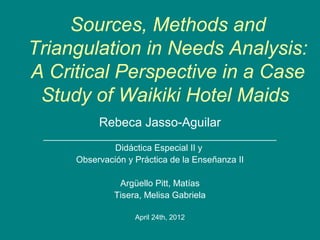Presentation on Rebeca Gasso Aguilar's "Sources, Methods and Triangulation in Needs Analysis: A Critical Perspective in a Case Study of Waikiki Hotel Maids"
- 1. Sources, Methods and Triangulation in Needs Analysis: A Critical Perspective in a Case Study of Waikiki Hotel Maids Rebeca Jasso-Aguilar _______________________________________________ Did©óctica Especial II y Observaci©«n y Pr©óctica de la Ense?anza II Arg©╣ello Pitt, Mat©¬as Tisera, Melisa Gabriela April 24th, 2012
- 2. The paper includes ? Comparison of methods and sources in NA (case studies and corpora) ? Findings of research in NA carried out in a hotel in Waikiki
- 3. What Where Why How Findings Conclusion
- 4. What ? Needs analysis research for language teaching through qualitative techniques: ? participant observation ? unstructured interviews ? questionnaires
- 5. Where ? A hotel from an important chain in Waikiki, a neighbourhood in Honolulu, Hawai.
- 6. Why ? Growing emphasis on NA for occupation specific ESP courses. ? Criticism to institutional ESP curriculum. ? To find out if participants were aware of their language needs
- 7. NA for the workplace / institutional NA: Criticism ? Institutions have clearly defined expectations of what they want workers to do. ? Institutions provide outsiders with that info. ?Result: a curriculum leading to marginalization, as it socializes students into passive acceptance of subservient roles. (Auerbach)
- 8. NA for the workplace / institutional NA: Criticism ESP channels immigrants into marginal occupations that offer no opportunity to gain additional language or job skills ensuring that they will have enough English to perform adequately in minimum-wage jobs (ĪŁ) yet not enough to move beyond this level of employment.
- 9. NA for the workplace / institutional NA: Criticism Solution (Goldstein): ? NA beyond the workplace, so as to provide language training that helps students function not just as cheap labor force but as functional members of English-speaking societies. ? What is important to employees should be considered together with what is important to employers.
- 10. Remember An obvious yet important goal of ESP should be for students to really benefit from English.
- 11. How / Solution to the problem of Institutional NA ? Use of multiple sources ? Triangulation of sources and methods (comparison & combination of sources, methods, findings, etc)
- 12. Institutions Students TRIANGULATION
- 13. Sources & Techniques used by Long, Svendsen & Krebs, and Cumaranatunge ? Language teachers with prior experience. ? People now undergoing or who have completed the education program. ? Those already employed in the occupation. ? Current or future subject area teachers or employers. ? Documents such as job descriptions and course reading lists.
- 14. Sources & Techniques used by Long, Svendsen & Krebs, and Cumaranatunge ? Published NA corpora. ? Interviews (structured & informal). ? Shadowing workers. ? Participant observation. ? Questionnaires.
- 15. The sources used in the case study in Waikiki ? Three housekeepers (day and evening shifts) ? Various supervisors ? The executive housekeeper ? Human resources people ? Task force meetings ? Morning briefings ? Housekeeping room ? Documents (job decriptions, procedures)
- 16. Methods ? Participant observations (tape-recording and note taking) ? Unstructured interviews ? Questionnaires (given to housekeepers and coworkers)
- 17. Findings ? The language needed for the hotel tasks the maids must perform is very limited ? The lack of English language skills does not affect their performance ? Institutional representatives perceive a need for housekeepers to develop better language skills ? Housekeepers identified a variety of language needs
- 18. Conclusion ? The use of qualitative techniques, multiple sources and triangulation allowed for the inclusion of learnersĪ» voices in expressing their needs. ? Participant observation was crucial for identifying reliable sources.
- 19. Conclusion ? The use of multiple sources shows that different actors have different perceptions of similar situations, which leads them to different objectives and felt needs. ? This study helped prove the reliability of insiders and the frequent unreliability of outsiders.
- 20. Thank you!




















